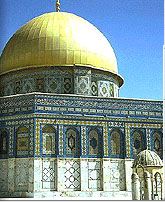|
|
|

The 'Menorah House'
|
Evidence of a Jewish settlement during the Early Islamic period in Jerusalem was provided in the excavations south of the Temple Mount. Uncovered beneath Umayyad 'Palace' III (eighth century CE) was a group of Byzantine-period dwellings, consisting of rooms surrounding an inner courtyard. |
|
One of these houses, near the southeastern corner of the Temple Mount, was preserved two stories high. In its debris was a white-plastered lintel with red-painted depictions of two menorahs, a lulav and a censer. These Jewish symbols are characteristic of Jewish art in the Byzantine period. Painted menorahs were also observed on the plaster-coated walls of the house. While cleaning the menorah lintel, a carved cross, surrounded by a circle, came to light. This seems to indicate that the lintel was a re-used object. |
|
The Jewish inhabitants of the house were probably one of the seventy families that had been granted permission to return to the city during the Early Islamic period. It has been suggested that this house served as a synagogue for the Jewish congregation at that time. Access to the house is prohibited due to safety regulations. |

|


